Treating Road Noise the Cascade Way.
By Paul M. Messett / Sales & Marketing Manager
01.02.08
Happy New Year! Here we are entering into another new year and already there is so much to discuss. I will slow it down a bit (10 deep breaths) and try to impart as much information as I can at various times during the next 364 days.
The initial response to the first few blog entries has been astounding and many readers have supplied me with some great topics to discuss. One topic that a lot of folks have been asking me to cover is how to effectively treat a vehicle floor pan to reduce road noise. I've been hearing things such as "I do not want to install multiple layers of a damping sheet, liquid goo and then foam into my car" and "has anyone thought about how heavy and time consuming this installation process is?" The use of multiple layers of vibration damping material is reminiscent of install practice popularized 10 to 20 years ago when installers would use 4 to 6 layers of heavy, stinking, asphalt damping sheets on the floor pan. We have developed specialized materials and install techniques to treat irritating road noise, read on and become enlightened.
What is the cause of this road noise you speak of?
Road noise is a combination of high energy sound that consists but is not limited to of a mix of frequencies produced by mechanical components, the exhaust system, tires contacting the road surface and airflow underneath the vehicle. In most cases, road noise is the single largest contributor to the overall noise floor within a vehicle passenger compartment.
Mechanical
Mechanical noise can be attributed to the drive train itself and is mostly mid band to high frequency noise. These types of noises are due to gears, suspension cycling, the transfer case and anything that comes out of the engine bay. Not all vehicles are subject to high levels of mechanical noise, but those of you who live life off road may have an idea of what I mean.
Exhaust
I'm sure that almost everyone here with an upgraded exhaust system is aware of increased noise from that system at some point. Sport compact cars fitted with coffee can exhaust tips, diesel trucks with 4" high flow exhaust, hot rods with tucked and down firing exhaust and anything with a Cherry Bomb installed are all good examples of noise producing exhaust systems. In many cases, these systems are much louder than stock systems and may be acceptable to the vehicle owner. Most folks obviously want the improvement in performance but detest what it does to the noise floor within the vehicle.
Tire
Tire noise is a huge contributor to road noise and depending on the hardness or cut of the tire, can even lead to an increase in structural resonance and vibration. The level and frequency of this noise can vary as the vehicle passes over various types of road surfaces to include dirt, asphalt, concrete, brick, grooved pavement, etc. For example, a truck with 44" Super Swampers is obviously going to make more tire noise than a BMW with Bridgestones.
Airflow
Airflow noise is also guilty of increasing the noise level within a passenger compartment. Airflow noise can vary depending on speed, the vehicles proximity to the road surface and other things such as the presence of an aerodynamic styling kit.
How can I defeat this monster?
Don't get caught up in the concept that more is better when it comes to automotive noise control, more is not always better and performance is not exponential, proper use of available materials is the key.
So many people have their own ideas as to how to effectively reduce road noise, but if you are familiar with Cascade Audio Engineering and our methodology you'll know that we believe in the "high performance, lightweight" approach. After all, you are not going to improve your gas mileage by installing several hundred pounds of sound control into your vehicle.
Defeating road noise requires no bit of magic, just effective use of the right materials. I'll be the first one to admit that in the past I have used multiple layers of a vibration damping sheet to reduce road noise, but that was a long time ago when the industry was young and advanced materials were unavailable. As a professional car audio installer, I dreaded doing this because it took so long to do (usually a week) and was a huge pain the arse.
Important, read this.
Vibration damping materials are designed to reduce structural resonance and vibration and in this application one layer is all we recommend. Dampers are not designed to block airborne sound or they would have STC values, they do not have NRC values because they are not absorbers, they have a Composite Loss Factor value which is a number between zero and one and includes a curve based on temperature. Vibration damping materials will reduce airborne sound when you put multiple layers (4+) in front of the offending noise source because at this point you have introduced so much mass in between the offending sound and your ears, but this technique is so outdated, heavy, time consuming, and expensive. Unlike a floating barrier, multiple layers of damping sheets do not have the critical airspring required to decouple the dense layers. Why anyone would still do this when there are specialized barrier materials designed for this specific application is beyond us.
Examples of Composite Loss factor data

Technology marches on.
As stated in the previous paragraph, we recommend one layer (and only one) of a vibration damping material and this could be a sheet material or liquid compound, either one and certainly not both. The vibration damper in this application will reduce the resonant frequency of the panels and give the floor pan a thicker, tighter feeling regardless of what the substrate is made of. The application of a vibration damping layer will increase the STC of the floor barrier system by 10%. If you follow up with 6" by 6" squares at various locations on the floor pan creating areas of differing density, you will then effectively damp the panel across a bandwidth of frequencies.
Now for the fun part.
The fun part is saving yourself a ton of time, money, weight and headache by using specialized "floating" floor barrier materials. The idea behind a "floating" floor barrier is to suspend a dense layer off of the surface of the floor pan to reflect high energy soundwaves. The dense layer is very effective at blocking high energy low frequency soundwaves and even more effective at blocking mid to high frequency soundwaves. The foam layer that suspends the dense layer is not in place to absorb sound because at that thickness coupled with the fact that we use a closed cell foam, the material cannot absorb sound. An open cell foam would absorb fluids and if you've ever reached underneath a wet carpet pad you'll know it can become a wet, sticky, smelly mess. So again, the foam layer essentially floats the dense layer and creates an airspring (air being the best insulator) and prevents the dense layer from being coupled directly to the floor pan. If this airspring did not exist and the dense layer was coupled, high energy airborne sound would transmit through the dense layer and into the passenger compartment.
Treating a small area of the floorpan and not the whole thing is about as effective as
screen door on a submarine.
VB3 Barrier Material
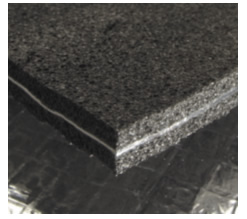
VB3 is a moldable floor barrier designed to be used on highly irregular areas of the floor pan like the transmission tunnel or anywhere the material has to mold absolutely to prevent difficulties when reinstalling the carpet kit or interior components. VB3 consists of two layers of 1/8" thick closed cell neoprene foam that sandwich a 15 mil layer of lead. Isn't lead bad for your health? Sure, if you eat it, but you won't and not in this application. One layer of VB3 (1lb ft²) is equivalent to four layers of a .070 vibration damping sheet (2.2lb ft²). Obviously the benefit here is much less weight and an install done in a quarter of the time. Now, VB3 is the most expensive material we offer so I recommend using it only where necessary. It does offer a higher STC rating than VB4, but the human ear cannot perceive the difference.
VB3 STC chart
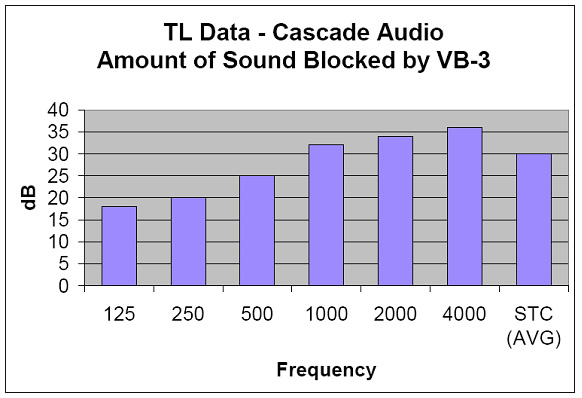
VB3 moldable floor barrier in '41 Willys
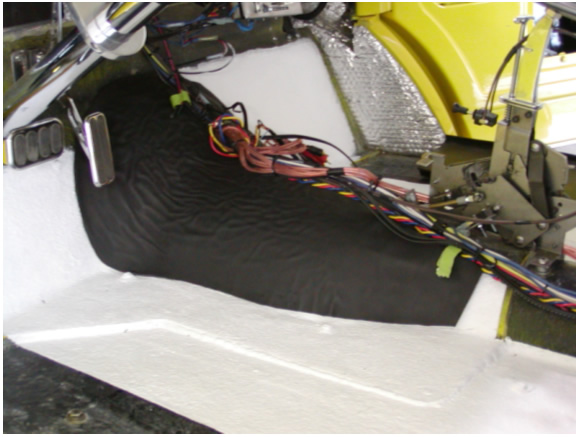
VB4 Barrier Material (upside down)
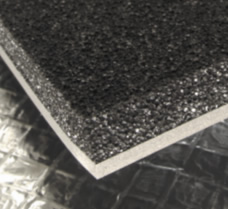
VB4 is also a specialized "floating" floor barrier material engineered to reflect high energy airborne sound. This material is flexible, not moldable, which makes it well suited for flat areas of the floorpan like the footwells, cargo area and on the backwall of the cab in a pickup truck. VB4 consists of a ¼" thick layer of neoprene foam that is bonded to a 1lb ft² mineral loaded vinyl barrier. The barrier material is the same product used to prevent airborne sound from transmitting through walls and ceilings in commercial and residential applications (i.e. theaters, studios, media rooms, condos). VB4 also happens to be less than half the price of VB3 and your wallet will appreciate that. The performance characteristics are similar to VB3 and superior to multiple layers of a vibration damping sheet.
VB4 STC chart
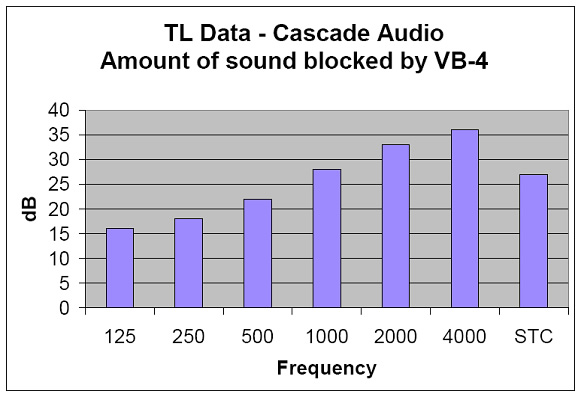
VB4 flexible floor barrier in '41 Willys
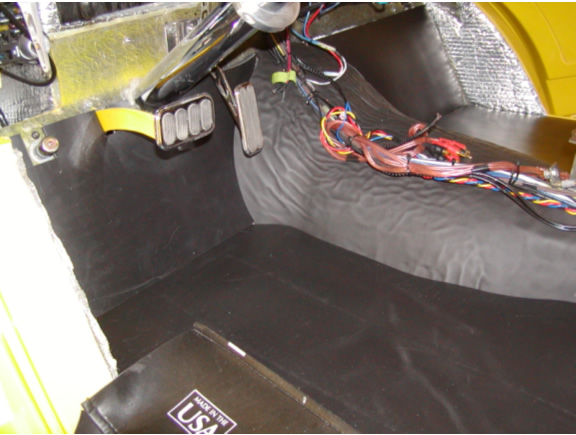
Install notes for high performance floor barriers.
1. Cover the entire floor area.
Airborne sound will follow the path of least resistance so don't think that you can just treat a small area over the wheel wells or above exhaust components. You have to treat the entire floor area or else the sound will make its way around the barrier and into the passenger compartment. Keep in mind the following.
a. 98% of airborne sound will transmit through a 2% opening in the surface.
b. One layer of floor barrier is all that is needed to achieve a significant reduction in the overall noise floor.
2. Keep gaps and seams tight.
This means that wherever pieces of floor barrier meet, it is necessary to keep the seams and
gaps as tight as possible. Otherwise, sound will transmit into the passenger compartment through the gaps. Seams and gaps can be taped with standard duct tape, however we strongly recommend using VB2, VB2HD or VMAX to tape the seams because it is much more dense and far more capable of blocking noise in this configuration that flimsy duct tape. In this configuration, the VB2, VB2HD or VMAX material is floating on top of the barrier and over the gap and not coupled directly to the floorpan.
3. Don't glue the barrier down.
It is not necessary to glue VB3 or VB4 down onto the floorpan, however you can glue it along the top edge onto a vertical surface if necessary. The reason why we do not suggest gluing is for the simple fact that if you ever need to pull up the material to access the floorpan or to run wiring, this is the way to go. Also, when the interior components are installed, the material will not slide underneath the carpet.
4. Keep the OEM carpet padding in place if you can.
If you are able to reinstall the OEM carpet padding, then by all means do so. The padding may be required to fill out areas of the carpet kit to achieve a perfect fit and installation.
5. Don't expect to improve upon the OEM firewall barrier.
Unless you have full access to the inside of the firewall, don't expect to improve upon what is there. In most cases of newer autos, the OE's are already using a dense barrier bonded to a foam backing that has been molded to the shape of the firewall. Often times it is extremely difficult to reach the top of the firewall and tighten the gaps around electrical harnesses, cables and heating/cooling lines. Don't be upset if the best you can do is over or underlap the OE barrier with the aftermarket product. Now if you've got full access to the firewall, then you're free to do whatever you want with the material.
Closer to Sonic Nirvana Than You Were
Installing a floor barrier system will do more for lowering the overall noise floor within your vehicle than any other single treatment. All of the VBLOK sound deadening products that we offer are modular by design which means you don't have to install everything at once. If you plan on follwing the "little bit here, little bit there" route, then consider starting with a floor barrier system. I hope this info has helped you determine what to do when trying to reduce road noise. A CAE-VBLOK floor barrier system is not difficult to install, lightweight compared to alternative techniques, a huge timesaver and can do more for quieting the car than anything else. Please feel free to contact me with any questions or comments you may have regarding this information.
Paul M. Messett
Cascade Audio Engineering
Sales & Marketing Manager
<< back
|